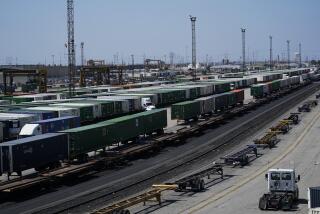U.S. Orders Trains to Sound Horns at All Crossings
- Share via
WASHINGTON — Even as the 21st century dawns with all its technological promise, federal officials Wednesday turned to a 19th century device to make railroad crossings safer--issuing a rule to require trains to sound their horn as a warning to motorists and pedestrians.
Although the loud horns often make life miserable for residents near the tracks, the Federal Railroad Administration’s rule would invalidate train whistle bans enacted in about 250 communities nationwide, including several in California, in response to complaints about the noise.
Federal officials plan to conduct hearings on the rule throughout the country, including one at a yet-to-be-specified California site. The regulation is expected to take effect in 2002.
Once the rule is enacted, cities could still petition the federal agency to establish “quiet zones” where trains would be prohibited from sounding their horns except in emergencies. But cities would have to take additional steps to stop people who refuse to be stopped by lowered gates and flashing red lights at railroad crossings.
Such measures could include installing additional barriers and cameras that photograph the license plates of drivers who pull around lowered gates. These additional safeguards, however, could prove costly.
The proposed rule is important to California because the state is undergoing a rail renaissance with such projects as the Alameda Corridor, a rail link that will increase freight traffic to and from the ports of Los Angeles and Long Beach.
Communities with train whistle bans mostly are in the East and Midwest. But whistle bans are in effect in several California cities, including Placentia and Sacramento. Los Angeles also has had a law on the books since 1978 prohibiting trains from blowing whistles in the Highland Park and Mount Washington areas except in emergencies.
The San Gabriel Valley community of Covina already has applied to federal authorities to become one of the nation’s first quiet zones.
The new rule is the result of a 1994 congressional directive calling on the railroad administration to issue a rule requiring trains to sound their horns or whistles at the nation’s 159,000 public railroad crossings. The legislation was in response to an increase in crashes along train routes in Florida where whistle bans had been enacted.
Federal officials say it took awhile to draft the rule because they wanted to consult communities and study new methods to reduce crashes at railroad crossings. Illinois is experimenting with giant nets that drop in front of drivers when a train approaches. Connecticut is testing a high-tech system that signals a locomotive engineer when a car is caught on the tracks.
In announcing the rule, Federal Railroad Administrator Jolene M. Molitoris said, “It is really about life and death and how we can prevent truly preventable injuries and deaths.”
Trains blow their horns at 96 decibels--the equivalent of someone using a chain saw. And they sound their horns four times--two long blows, a short blow and a final long one--before approaching a crossing.
Nationally, deaths and injuries from railroad crossings are down. Still, federal officials said there were 3,508 collisions at crossings last year, including 431 deaths. In Southern California, a spokesman for Metrolink said the six-county commuter rail service had one death on the tracks last year, excluding suicides, down from 13 in 1998 and 16 in 1997.
Judging by some of the comments received by the federal agency, the rule is sure to be controversial.
Some local officials suggested that trains should be required to blast their horns only at crossings with traffic problems.
More to Read
Sign up for Essential California
The most important California stories and recommendations in your inbox every morning.
You may occasionally receive promotional content from the Los Angeles Times.














